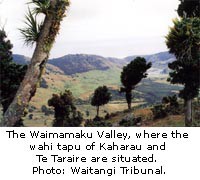Case study: Kaharau and Te Taraire
The three case studies which follow illustrate how different areas of Te Roroa land were sold or alienated by various means. Locate each of these areas on the map as you read these case studies.
Map of Te Roroa lands [GIF, 173 KB]
Case Study: The Loss of Kaharau and Te Taraire
Kaharau and Te Taraire were wahi tapu included in the Waimamaku 2 block. During the sale of the land, there were three different survey plans made of the block and confusion arose over which areas were to be kept out of the sale.
- Smith's Plan: In May 1875, a Government surveyor, Stephenson Percy Smith, submitted to the Native Land Court only a rough sketch plan of the Waimamaku 2 block, prepared for the court hearing in June. Smith had asked two men, the Wilson brothers, to survey the land but this had not yet been done. Smith's sketch plan clearly showed Te Taraire and roughly showed a 'reserve' (Kaharau) outside the area of land for sale.
- The Wilson Brothers' Plan: Produced over a month after the court hearing, the Wilson brothers' plan clearly showed Kaharau and Te Tarai-re as areas to be reserved from sale. Te Roroa chiefs saw this plan and believed that it would become the official record of the Waimamaku survey. But the court rejected it as imperfect.
- Kensington's Plan: The Government's chief draughtsman, W C Kensington, drew up a plan in December 1875. He produced it from his office and did not visit the site. His plan was sent to the court long after the hearing but was attached to the deed of sale, thus becoming the official record of the land that had been sold.

If Kensington had gone to Waimamaku, the chiefs would most likely have pointed out to him the features of the land which traditionally marked the boundaries of the wahi tapu to be reserved. Since the wahi tapu at Kaharau and Te Taraire were not marked on Kensington's plan as reserves, they were officially included in the sale, unbeknown to Te Roroa and contrary to their wishes.
Next: Case Study: The Sale of Waipoua–Maunganui
This page was last updated: